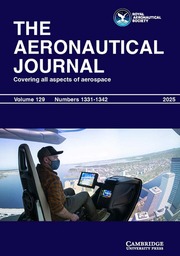No CrossRef data available.
Article contents
Development of a real-time simulation of aVstol aircraft
Published online by Cambridge University Press: 04 July 2016
Abstract
This paper describes the implementation of the DRAGVAM87 model in Modula-2, using the Hood designmethodology, and the subsequent validation of thereal-time model running on a personal computer. Thework demonstrates that the execution speed of themodel is not compromised while overall validity ofthe simulation is maintained. The model wasinterfaced with an existing simulation of the SeaHarrier head-up display (hud) in order to providevisual cues of the aircraft's motion during pilotedflight.
Information
- Type
- Research Article
- Information
- Copyright
- Copyright © Royal Aeronautical Society 1996
References
1.
Venieris, J.
Development of the Sea Harrier Head Up Display
Simulation in Vstol PIA Mode, MSc Thesis, College of
Aeronautics, Cranfield
University,
1993.Google Scholar
2.
Muir, E.A.
and Kellett, M.G.
The RAE generic Vstol aircraft model — GVAM87
documentation guide, Report, Royal Aerospace
Establishment, 1990.Google Scholar
3.
Zammit, S.
Conversion of existing Fortran simulation
programs to a general purpose simulation language,
American Institute of Aero nautics and
Astronautics, 1988, pp
42–48.Google Scholar
4.
Delatte, B.,
Heitz, M.
and Muller, J.F.
Hood reference manual 3.1,
Prentice-Hall,
London,
1993.Google Scholar
5.
Robinson, P.J.
Object-oriented design, No. 11 in Applied
Informa tion Technology,
Chapman and Hall,
1992, pp
1–10.Google Scholar

